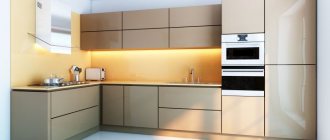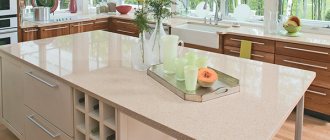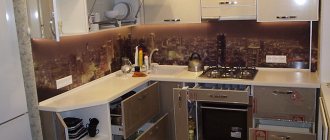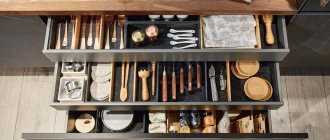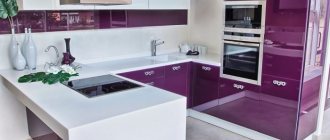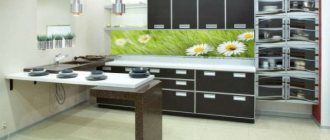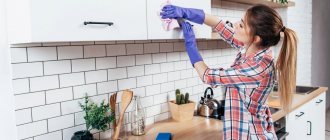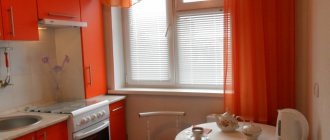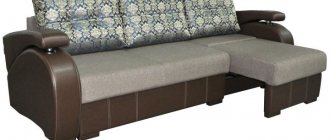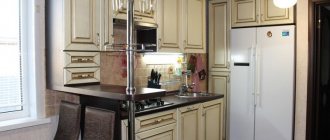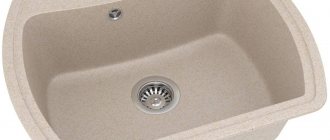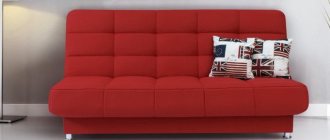13.05.2018 0
18692
One of the most pressing and troublesome issues when decorating a kitchen is the choice of material for the facades of the furniture. The difficulty lies in the fact that furniture must not only fit harmoniously into the overall interior and delight with a fresh design, but also guarantee practicality and durability, and such a combination is quite rare. Wanting to get these characteristics in one set, modern homeowners are increasingly choosing plastic, but does this solution live up to expectations? In order to figure it out, let’s study the features of plastic kitchens, compare the pros and cons, get acquainted with reviews about them and evaluate the photos in the interior.
Advantages and disadvantages
Kitchens with plastic facades are known for their advantages:
- attractive and fashionable appearance;
- high strength;
- resistance to steam;
- variety of designs and colors;
- affordable price.
The disadvantages of headsets include:
- change in color of the facade with constant contact with direct rays of the sun;
- areas where dirt accumulates at the junction of plastic and edge;
- loss of attractive appearance over time for aluminum and polymer edges.
A plastic kitchen has more positive than negative qualities. Because of this, they are in demand among buyers.
How to care for matte facades
The surface of the matte façade is cleaned using special means. First, wet cleaning, then wiping with a dry cloth or rag to remove moisture and stains. The wood covering is processed by a steam generator.
It is better to remove stains that appear on the coating quickly - over time, the contamination will be absorbed into the porous structure of the facade, and it will be difficult to wash it.
A matte facade made of cheap material is difficult to clean in any case. You shouldn’t skimp on the quality of the façade coating only to have to worry about cleaning it later.
What kind of plastic coating can there be?
Plastic for the kitchen is available in several options, from acrylic to PVC film.
Plastic acrylic kitchens in the photo
PVC furniture
Sets with plastic facades are cheaper than furniture made from natural materials, they are not afraid of constant temperature changes and are made in a variety of colors. The only disadvantage of PVC is that it is difficult to maintain (with a matte texture) and the possibility of deformation of the applied decorative pattern on the surface of the furniture.
Acrylic panels
The modern and multifunctional material is characterized by a long service life, during which it retains its original appearance. The advantages of the material include:
- increased strength and resistance to scratches, steam and water;
- no burnout effect;
- uniform gloss;
- long-term operation - from 30 to 40 years.
Experts considered the negative properties of acrylic panels to be the frequency of cleaning (removing fingerprints), high cost and the possibility of using only for smooth and solid facades.
Acrylic panels
Acrylic film
This material is inferior in characteristics to sheet acrylic, but is more resistant to temperature transfers than PVC film. Acrylic film comes in a variety of colors, and can also imitate wood or other materials. There are options with a plain surface or photo printing. The facade can be matte, pearlescent or glossy.
HPL plastic for high pressure cladding
It is a durable and reliable composition and has a high cost. HPL plastic has high resistance to unstable temperatures, moisture, and mechanical damage (scratches). The material has good hardness and rigidity characteristics.
Medium and cold pressure CPL plastic
Among experts it is considered less convenient; its structure is similar to leatherette. Negative qualities of CPL plastic include fading in the sun and scratches under mechanical stress.
The low level of strength is also reflected in the price - the material is cheaper than HPL plastic. Appearance does not meet expectations.
CPL plastic
Other interesting solutions
When decorating a kitchen, many housewives are faced with an important choice and cannot decide which is better: plastic or acrylic?
Indeed, acrylic has a number of advantages. Firstly, it is more practical, as it retains its original appearance longer. Secondly, the mirror surface reflects light and visually expands the space, which is especially important for small kitchens. One of the most important advantages of acrylic kitchens is that they are created without volatile compounds, impurities and resins. But there is also a significant difference - this material is significantly softer than plastic.
Compared to plastic ones, acrylic headsets are more durable.
For those who could not make a choice, manufacturers offer a new solution - acrylic plastic. The basis of the furniture will be plastic, and the covering will be made of acrylic. Kitchens made from this material combine all the best characteristics of plastic and acrylic, while the disadvantages of both materials are neutralized in this case.
Acrylic-plastic kitchen set.
Modern color options
The color range of kitchen sets is endless: from snow-white to charcoal black. Each of the well-known styles requires the purchase of a set of a certain color, combined with the shade of the walls.
High tech
The design requires a minimum amount of decor; two-tone solutions with contrasting or similar shades are welcome in kitchens. Furniture should have clear lines, radius or straight fronts.
Classic style
Classics and plastic do not combine if the surfaces do not imitate wood: oak or walnut wood. You can use beige, brown or white shades, but you should not combine more than 2 colors.
With a classic style, choose matte rather than glossy solutions. The fittings should fit into the overall concept and look like old gold, silver, copper or bronze.
Classic kitchens made of plastic in the photo
Loft
The style requires a large number of glossy surfaces: glass, metal or plastic. To get the maximum effect, it is better to purchase acrylic options.
Minimalism
The combination of simplicity and practicality does not tolerate excessive decoration and pretentiousness. Furniture can be cream, milk, honey, coffee or pearl shade. It should have sliding structures and matte surfaces.
Minimalism in the kitchen
Plastic kitchen interior
In a kitchen interior, not only furniture can be made of plastic. A good solution could be plastic kitchen countertops or a plastic shelf. The design of such products delights with stylishness, diversity and originality of color.
For what purposes can a plastic shelf be used in kitchen design?
- For storing everyday items;
- For indoor plants;
- Used as shelves;
- As an element that combines decorative elements.
The design of the shelf must certainly be combined with the design of the plastic kitchen. At the same time, the height of the shelf is not particularly important, so you can choose both high and low options.
Models with photo printing
They help create unique interiors. In addition to ready-made options, you can order any design from the manufacturer or apply your own photo to the cabinets. The set will automatically attract attention, which will allow you to ignore the decoration of the rest of the room.
Classic photo printing options include:
- photos of fruits and flowers, landscapes and abstractions - with a plain tabletop;
- black and white variations - when using the classic style;
- images of flora and fauna, various hieroglyphs - for adherents of the Japanese version;
- photographs of birds, plants, cities or coffee are used for Art Nouveau.
The basis of photo printing is acrylic film. It is quite moisture resistant and practical.
Corner set with facade photo printing
Technological features
The production of plastic facades involves gluing MDF boards under pressure with a thin layer of plastic, while the ends remain uncovered. The end surfaces are glued on another edge banding machine.
To process facades, roll or sheet plastic grades are used:
- CLP – roll for cladding without heating under medium pressure;
- HPL is sheet plastic, cladding is carried out under high temperatures and under high pressure.
Of course, the second method of applying a layer of plastic implies higher quality, but also more expensive panels for the production of kitchen facades.
The color range is quite diverse: from absolutely white to deep black, from bright even flashy “parrot” colors to delicate pastel colors. The textures are also varied: it can be a surface stylized as the most expensive type of wood or noble marble, have a complete resemblance to fabric or leather, a pattern in the form of dew drops on the grass or beautiful flowers.
Recently, facades covered with acrylic-based plastic have become popular. The essence of the new product is as follows: various (often fantasy) patterns of the same color as the background, but glossy, are applied to a matte background, or vice versa - matte patterns on a glossy background.
Which is better – matte plastic for the kitchen or glossy?
After choosing a suitable kitchen set, the owner is faced with the question of the features of its surface:
- Gloss – looks better, has a beautiful appearance, and its shine attracts attention. This material has a serious drawback - even superficial scratches will be noticeable, not to mention handprints. This option is not suitable for families with small children, for whom it is difficult to explain the fragility of a smooth surface. As a result, in a short time the kitchen will resemble something that has been used for a long time, and it will have to be replaced.
- Matte does not evoke a festive mood with its appearance, but is more practical in many respects. Matte plastic does not show stains, scratches or fingerprints (example: Italian Phoenix kitchens). Designers consider the negative properties of this option to be difficult to maintain - you will have to spend more time cleaning the facades.
Kitchen sets with printed patterns deserve special attention. The images look unusual and elegant, but they are not advisable to use in miniature rooms. The drawing will emphasize the modest size of the room.
Combination of matte and glossy surfaces in the headset
Subtleties of choice – Colors of kitchen facades to match plastic
Today, many people want to buy custom-made kitchens made of plastic, and this is justified by the fact that they want to experiment with colors. Not surprisingly, most families spend a lot of their free time in this part of the house. And of course everyone wants to make it unique, beautiful and enjoyable to spend time with.
White plastic sets are designed for small rooms that need to be visually enlarged and made more modern. This color is suitable for a classic, modern or high-tech interior.
“White color will help absolutely any equipment fit into the set.”
Modern beige plastic kitchens are just as versatile as the previous look. They look great against a dark background, so we recommend choosing dark walls and apron. Beige covers dirt and stains well.
Read a useful article on choosing an apron - Wall panels for the kitchen .
If you really want something bright and unusual, choose red . It always looks expressive and bright. But it will be difficult to choose a wall panel and floor covering for such a set.
“In this case, designers suggest combining three colors – white, gray, red.”
The article will be useful to read - Flooring .
Ideal for some housewives would be brown plastic kitchens . This is a very noble color that goes well with many others. Goes well with white, beige, light green colors.
“Designers often suggest combining brown lower facades with white upper facades.”
Another classic combination is black and white plastic kitchens . They look impressive, expensive and stylish. But in the following photos you can appreciate the elegance of such a set in real apartments.
In the catalog of every company that creates designer kitchen sets, there are a lot of color variations and shapes. After all, clients are different, with their own preferences and tastes.
“Do not choose bright fronts for a small kitchen space.”
Care Tips
To increase the service life and visual appeal of a furniture set, it is necessary to follow a number of rules:
- eliminate sudden temperature changes - the product easily tolerates temperatures from +10 to +40 degrees;
- do not expose the set to the open sky;
- protect it from exposure to direct sunlight;
- quickly remove any spilled liquid - if the base is of poor quality, it will swell over time;
- Of all types of frames, give preference to aluminum - it is considered a durable option;
- get rid of contaminants in a timely manner;
- When washing, use special polishes for plastic surfaces and soft fabrics;
- remove fat from the facade with ordinary liquid soap or dishwashing detergent;
- use a hood with sufficient power so that fumes do not settle on light-colored cabinets.
Manufacturers of the kits do not recommend using aggressive or bulk care products, alcohol compounds, solvents, acetone or turpentine. When washing, do not use hard brushes or sponges - they can scratch the coating.
A kitchen set made of high-quality plastic is considered durable, beautiful and comfortable. Before purchasing furniture, you need to really evaluate the room (size, illumination and sun exposure) and only then choose matte or glossy options. Proper care of your headset will prevent it from quickly aging and becoming shabby.
Facade material
The base for the plastic set is the usual materials: MDF, chipboard and wood. The latter is used much less frequently, since the attractiveness of the wood pattern and rich color range allow it to be used without any additional finishing.
- Tree. As a base, choose wood species that are resistant to moisture and not prone to rot: pine, spruce, larch. Expensive wood - beech, oak, cherry - is unprofitable to use in this capacity.
In this kind of kitchen set, wood, according to reviews, has one significant advantage - durability. Plastic protects wood from moisture, preventing swelling or cracking. And only when we are talking about sheet material, that is, about kitchens in a higher price segment. In addition, the aesthetic qualities of wood usually exceed its finishing capabilities.
- MDF is a much more popular option, and its use is quite justified. MDF is a wood-fiber board produced by pressing small sawdust with a binder. MDF does not have a structure like wood (a certain direction of fibers), which is a plus for kitchen furniture: the material is not prone to swelling and cracking and can even withstand direct contact with water and steam.
The photo shows a small kitchen made of MDF.
MDF is durable and retains its dimensions, that is, the doors do not begin to deform over time and close poorly. Any finish for MDF can be used. An additional plus is that MDF is used to make curved facades, and this is one of the most striking solutions for a modern interior, especially when arranging a corner kitchen.
The disadvantages of the product include the cost. Instability to ultraviolet radiation or moisture does not relate to the MDF itself, but to the quality of the finish: as reviews indicate, in this case we are talking about PVC film.
- Chipboard – chipboard. The option is much more budget-friendly. Chipboard is less resistant to dampness and temperature changes: near the sink and stove, the set quickly becomes relatively unusable. Protecting the material with PVC film significantly extends the “life” of the kitchen set.
Bent facades cannot be made from chipboard, and carving is impossible here. The maximum is the production of paneled sashes or sashes in an aluminum frame.
A typical combination is a cheaper material (chipboard) with a cheaper finish - PVC film. MFDs are preferably finished with sheet plastic. Combining materials allows you to reduce the cost of the entire set, but not compromise too much in quality: the facades are made of MDF, and the body is made of chipboard.
Our photo gallery:
Plastic kitchen design
Plastic is truly an extremely diverse material, so it can bring any idea to life. It is not limited to the interior style: even the most classic kitchen can be made from MDF coated with plastic.
- Color range - plastic is an organic substance, which means organic dyes are used in its production. And the latter create an unlimited range of colors: light and dark shades, warm and cold tones, gradient color changes, and so on - any solutions are available. Moreover, this applies equally to PVC film, acrylic, and acrylic panels.
- Drawing. The most famous option, judging by the reviews, remains the wood pattern. However, in most cases this applies to PVC film and HPL plastic. In the first case, this is due to the transparent appearance of the material, clearly hinting at fragility. In the second - a high resemblance to a tree.
Acrylic film, like acrylic panels, can reproduce the pattern of any natural material, including wood. This rarely happens: gloss is more often used to reproduce stone cladding, and even more often to obtain surfaces of bright or pastel shades. Colors combined with mirror shine look much more impressive. Quite often there is an ornament, mostly floral, but sometimes heraldic and even geometric.
The photo shows a floral pattern on a glossy facade.
- Photo printing on MDF significantly expands the design capabilities of acrylic panels. Judging by the reviews, photo printing is the most interesting design for straight and corner modern kitchens. As a rule, it occupies only part of the facades and is combined with doors of the same color or even imitating wood.
- Texture - gloss, of course, is one of the most famous, as reviews indicate. An acrylic panel and an acrylic film can be glossy. The option is universal and equally good in both light and dark colors, especially since the level of gloss can be adjusted. Finishing can be done in both matte and satin versions, but this rarely happens.
The photo shows a small glossy kitchen.
PVC film is matte, since it usually imitates natural materials, or embossed. HPL plastic is also almost always structured: in this way, the grain of the wood is emphasized, achieving greater similarity.
- The shape of the facades is limited by the finishing characteristics. Smooth surfaces can be covered with any type of plastic, but milled and bent ones cannot. For the latter option, only PVC film and acrylic film are suitable. This limits the use of finishing, especially in the manufacture of corner kitchens: here, more than anywhere else, practical and beautiful curved facades are convenient. But for corner sets made of acrylic panels, this possibility, alas, is excluded.
The photo shows a small kitchen with curved facades. - Combination. Kitchens with plastic finishing allow you to combine imitation materials in a way that is impossible in any other option. Glass and pattern, gloss and wood, aluminum frame and photo printing - any options are feasible.
Kitchens made of plastic are varied - from very budget models coated with PVC film to expensive sets with acrylic panels. Their qualities differ so noticeably that it is worth talking separately about each type of this furniture.
Acrylic coated panels
It is quite difficult to find differences from film in appearance, but the properties of the two materials are different; the plastic plinth for the kitchen will be manufactured in several stages.
Initially, a design with a certain color is applied to MDF; a printer is used for this. Then the entire plane is covered with acrylic and exposed to ultraviolet light after each stage; this is necessary for high-quality fixation of all components of the product.
Among the advantages, it should be noted that it is absolutely resistant to vapors and high temperatures; moisture and dampness cannot damage the structure of the base. The material does not fade when exposed to sunlight and copes well with various soot, grease and acids.
Photos of a plastic kitchen in this design look beautiful, and based on positive data, the service life is quite long.
Color solutions, of which there are a huge variety, will not force you to think long about your choice. Gloss is quite popular; facades with this solution have remained favorites for many years.
The ability to change the degree of gloss, up to mirror-like, pleasantly surprises buyers. One of the disadvantages is the impossibility of repair; only a thorough replacement of the part can save the damaged part. The sheets cannot be attached to the radius part of the structure, and not everyone can afford the price.
Pros and cons of plastic kitchens
- Increased impact resistance.
- High wear resistance.
- Bright and attractive appearance.
- Scratch resistant.
- Water resistance.
- Stain resistant.
- Good light fastness.
- High temperature resistance and fire resistance.
- Hygiene.
- Environmentally friendly.
- The weak point is the presence of edges. Aluminum profile edges become dull over time and dirt accumulates along them. PVC edges peel off, especially near the oven.
- Fingerprints remain on glossy plastic, while matte plastic is less easy to clean.
- Compared to enamel coating, there is a small selection of colors and shades.
What is the appeal of acrylic kitchens - the modern view of designers
If designers need to choose a material for a kitchen from acrylic or plastic, then they choose the first. After all, it looks appropriate in interiors of modern styles (high-tech) and complements the abundance of high-tech equipment with a glossy shine.
In minimalism, an acrylic kitchen allows you to get a stylish design with a lack of decor, which is the most important thing for style.
For a modern style with smooth symmetrical shapes and rounded lines, this coating will create a cozy atmosphere. A shiny surface will add light and warmth. Acrylic kitchen facades with several shades look interesting: one basic and the other bright.
Interesting! The coating is not recommended for use in Country, Provence and Classic. Because the originality of styles will be violated. For them it is worth using natural matte materials.
Bright kitchen-living room in a modern style - interior design photosKitchen design in beige tones: fashionable interior trends
- Kitchen interior ideas using red color
Another important point why designers prefer this product is environmental friendliness. But you shouldn’t listen only to them. If other residents don’t like the dazzling shine, then don’t go against it. However, numerous reviews say that no one regretted it.
How to choose
The selection of a kitchen made of matte plastic or a set with photo printing is carried out based on an assessment of the budget and the characteristics of the kitchen space. The “economy” option is chipboard covered with a polyvinyl chloride film.
Products made from MDF with panels lined with HPL plastic will cost more, but their quality is noticeably better. Such kitchens are made to order, taking into account all the wishes of the customer.
The preparation of the project begins with taking into account the placement of all communications: sockets, pipes, etc. They calculate places for built-in appliances, microwaves, and arrange lighting. The final touch is the choice of design.
Production technology
The production technology for acrylic headsets is similar to the production of plastic headsets. There are two types of manufacturing for flat and curved shapes.
To get a flat panel, take an MDF board, treat it with a solution to harden it, and prime it. Then the drawing is applied with a printer and everything is covered with acrylic. Due to the fact that it is a colorless material, you have to manually add the necessary pigment. A layer of diluted pigment is applied to a slab up to 3mm thick. and treated with ultraviolet light. This allows the surface not to lose color over the years. Then the slab is cut to the required dimensions and sent to the assembly shop.
To obtain curved panels, acrylic tape is glued to MDF, chipboard (pre-impregnated with absorbents) with special glue or resin, and sent for hot pressing. The sections are covered with a waterproof acrylic film. This is how ready-made acrylic panels for the kitchen are obtained.
Purple kitchen design: photo examples of real interiorsWall color in a kitchen with brown furniture: features, how to place accents
Chocolate color in the kitchen interior - 78 best photos of modern design
There is a third type of mirror coating that you can do yourself - painting. If there are many fans of painting sets with acrylic paint or enamel. In this way, you can frequently update your furniture at low cost.
Types of facades
Facade finishing can be of three types. Let's look at each and find out which is better and more durable:
- Postforming technology can be used with film. The sashes need to be rounded and wrapped around with acrylic film to capture the two edges. The edges at the top and bottom are sealed with PVC film. This way the product comes out the same color on all sides.
- The edge is distinguished as a separate type of facade finishing, although it is an integral part of postforming and without it the production of the panel will not be completed. The edge is made of PVC or acrylic film. The surface coating can be on one side or on both sides.
- Aluminum frame. To complete the finishing and give the ends a beautiful appearance, the panel is inserted into an aluminum frame. Frames are installed in different widths depending on the design. Aluminum is a delicate metal, so it should not be exposed to aggressive cleaning compounds with abrasives, so as not to provoke darkening.
Acrylic kitchens with aluminum frames cannot be glazed with ordinary glass. For strength and to avoid darkening, carefully order special acrylic glass.
A little about the production of kitchen facades
The basis for the production of modern kitchen furniture (with the exception of wooden facades) are two materials: particle board (chipboard) and medium density fiberboard (MDF). The abbreviation MDF is taken from the English name of this board (MDF).
Chipboard is usually used in the cheap segment, MDF in the more expensive segment. MDF has increased strength, heat resistance and lower formaldehyde content. Next, a finishing coating is applied to this base: plastic, PVC film, veneer, acrylic or enamel.
Modern HPL plastic
A similar material is made by pressing multilayer paper, which is impregnated with thermosetting substances. The qualities of this coating are truly outstanding, which is why it attracts the attention of more and more people.
Heat resistance is excellent, moisture resistance is excellent, and the ability to withstand oil, dyes and even gasoline produces a stunning effect. Plastic blinds for the kitchen can complement the interior; they will harmoniously combine with other elements and bring joy. The durability of a product made of HPL plastic is unlimited; everything will depend on operational aspects and care.
The coating can withstand temperature fluctuations of simply unimaginable numbers from +50 to -60 degrees, which makes it in demand. Mechanical damage causes minimal damage to plastic, and this indicator is complemented by the low flammability of the substance; it belongs to class G 1.
The choice of shades will pleasantly please you at the moment of selecting the desired color; applying a pattern of stone, wood or metal is also possible. Action enhancers in the form of various textures are in demand; glossy, matte and imitated samples are available for combination.
An important disadvantage is the possibility of application only on flat surfaces. Bent or paneled furniture doors cannot be made using this technique. It is impossible not to pay attention to the cost, it is quite high, this is due to good durability indicators.
